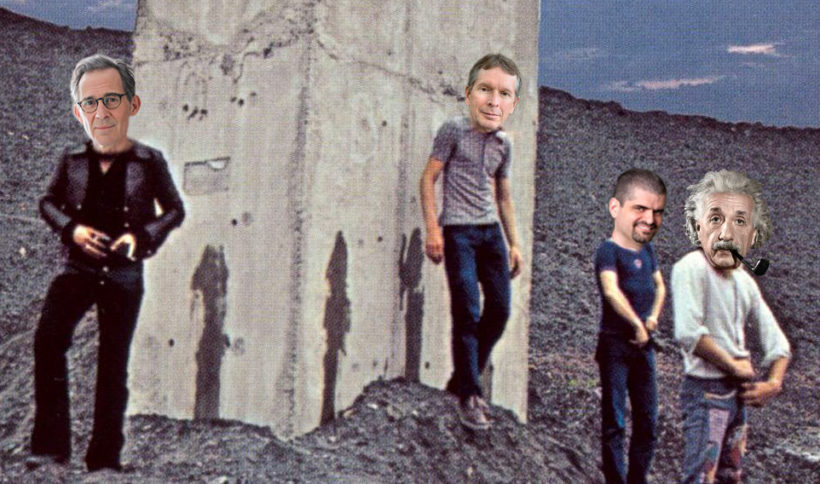Newton’s Woo
About three hundred years ago in 1728, Isaac Newton put forth a theory that has since become very well known. He termed this idea The Law Of Universal Gravitation.(1) The basic premise of his concept was that celestial bodies are pulled toward one another by an invisible force called gravity. This theory, when it was first presented, was mocked and dismissed by the majority of academics who reviewed it in the early 18th century. In the early 1700s, the idea that influences could be transmitted without contact being involved was considered absurd.
Cut to one hundred years later. By the middle of the 19th century, Newton’s “absurd” theory had not only been accepted, it was considered sacrosanct. To go against Newton’s theory of gravity in academic circles in the late 19th century was to risk being thought of as a flake.
Einstein’s Woo
In 1915 Albert Einstein was strongly challenged and in many cases ridiculed when he put forth his Theory Of General Relativity.(2) In this theory he declared that it is the curvature of space-time and not an invisible force that draws celestial bodies toward one another. This perplexed the majority of Einstein’s Newtonian colleagues who countered that only objects can be curved and that space-time is not an object. By the middle of the 20th century Newton’s theory of gravity was considered oldfangled and Einstein’s General Relativity theory became the accepted model.
Albert Gets Spooked
In 1935 Albert Einstein co-authored a paper with Boris Podolsky and Nathan Rosen that came to be known as the “EPR” paper.(3) The paper showed that two quantum particles can interact in such a way as to link both their spatial coordinates and their movements even when the particles are widely separated. As a result of this “entanglement”, the position or the momentum for one particle at one end of the galaxy will influence (in a fixed way) the position or the momentum of the other linked particle at the other end of the galaxy.
Einstein was deeply troubled by these findings which he dubbed “spooky action at a distance”. His initial response was to doubt his woo-ish findings, saying that the problem was likely due to the incompleteness of quantum mechanics. By the middle/end of the 20th Century though, multiple experiments would prove Einstein wrong. Now, in the early 21th century, entanglement is widely acknowledged as a legitimate scientific theory.
Galileo’s Wacky Idea And The Copernican Revolution
In a letter to Johannes Kepler in August of 1610 astronomer/physicist/engineer Galileo Galilei complained that many of his most prominent critics in the field of philosophy “have steadfastly refused even to look through the telescope. What shall we make of this? Shall we laugh, or shall we cry?”(4) Galileo was a proponent of Copernican Heliocentrism, an astronomical model developed by Nicholas Copernicus in 1543 that placed the sun (rather than the earth) at the center of the universe. Galileo’s findings were deemed “heretical” by the Church in the 17th century. He was forced, under threat of ex-communication and death, to recant them.
As we all know, Galileo’s claim that the sun is the center of our universe turned out to be correct. In fact, the massive paradigm shift that ensued upon the proliferation and eventual acceptance of Copernican Heliocentrism in the century that followed was dubbed “The Copernican Revolution”.
Woo’s Next
In the first two decades of this, our 21st Century, a new model of reality has been put forth by a small group of scientists and philosophers. Their hypothesis is as potentially groundbreaking as any of the aforementioned theories in this article. Essentially, this new theory, which is far more empirically sound than the currently accepted theory, posits that the underlying substrate of the reality in which all experience appears, with which it is known and out of which it is made, is consciousness. This “consciousness only” model directly challenges a concept that, for centuries, has been the accepted central pillar upon which a whole host of other theories about ourselves and our world have been constructed. This now teetering, cracking pillar is known as materialism and/or physicalism.
Rather than go into another series of paragraphs of description here I’m going to point you directly (via the links below) to YouTube clips of three prominent proponents and articulators of this new consciousness model of reality. I’ve listed the clips (below) in an order I feel works best as an intro to this new hypothesis. You are free, obviously, to view them in any order you wish. The three thinkers are Dr. Bernardo Kastrup, Rupert Spira and Dr. Donald Hoffman. I’m also providing a link to an essay I wrote for Pressenza a year ago entitled “Free Your Mind And Your Ass, Which Is Not Separate From Your Mind, Will Follow (A Case For Universal Consciousness)”, for those who are interested in reading an uncredentialed (though still bloody good) take on the subject.
Enjoy!
- Rupert Spira – “Consciousness Is Not Produced By The Brain”
- Dr. Donald Hoffman – “Do We See Reality As It Is?”
- Dr. Bernardo Kastrup – “Essentia/Analytic Idealism Course”
- Mark Lesseraux – “Free Your Mind And Your Ass, Which Is Not Separate From Your Mind, Will Follow (A Case For Universal Consciousness)”.
BIBLIOGRAPHY:
- Sir Isaac Newton, “Newton’s Law Of Universal Gravitation”, Physics Classroom,
- Albert Einstein, “Einstein’s Theory Of General Relativity”, Space.com, June 2021
- “The Einstein, Podolsky, Rosen Argument”, Stanford Encyclopedia Of Philosophy, May 2004
- Doug Linder, “The Trial Of Galileo”, 2002






